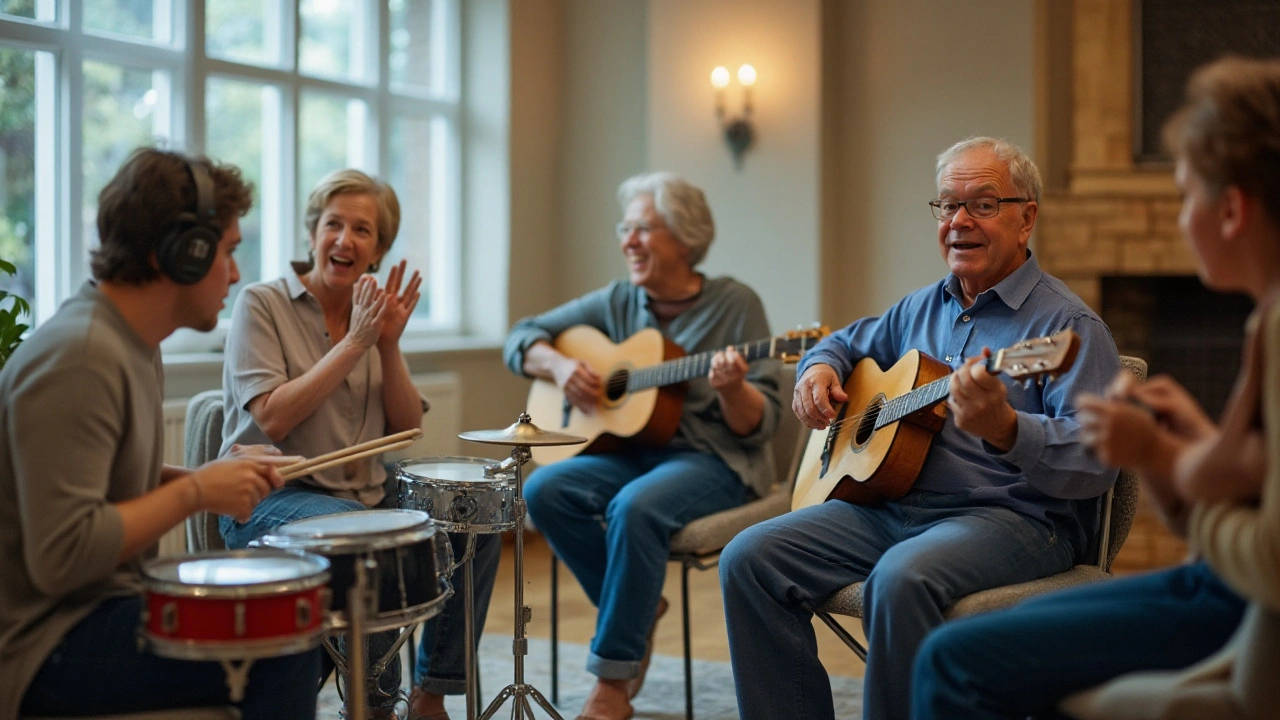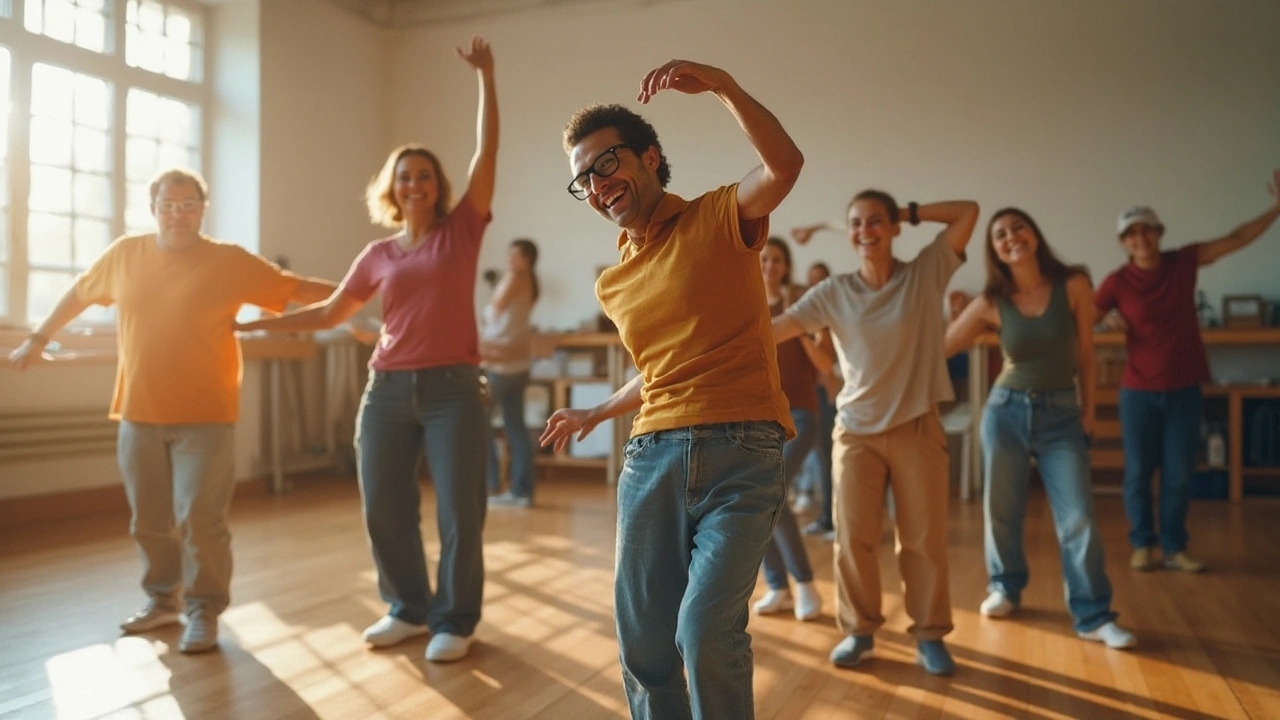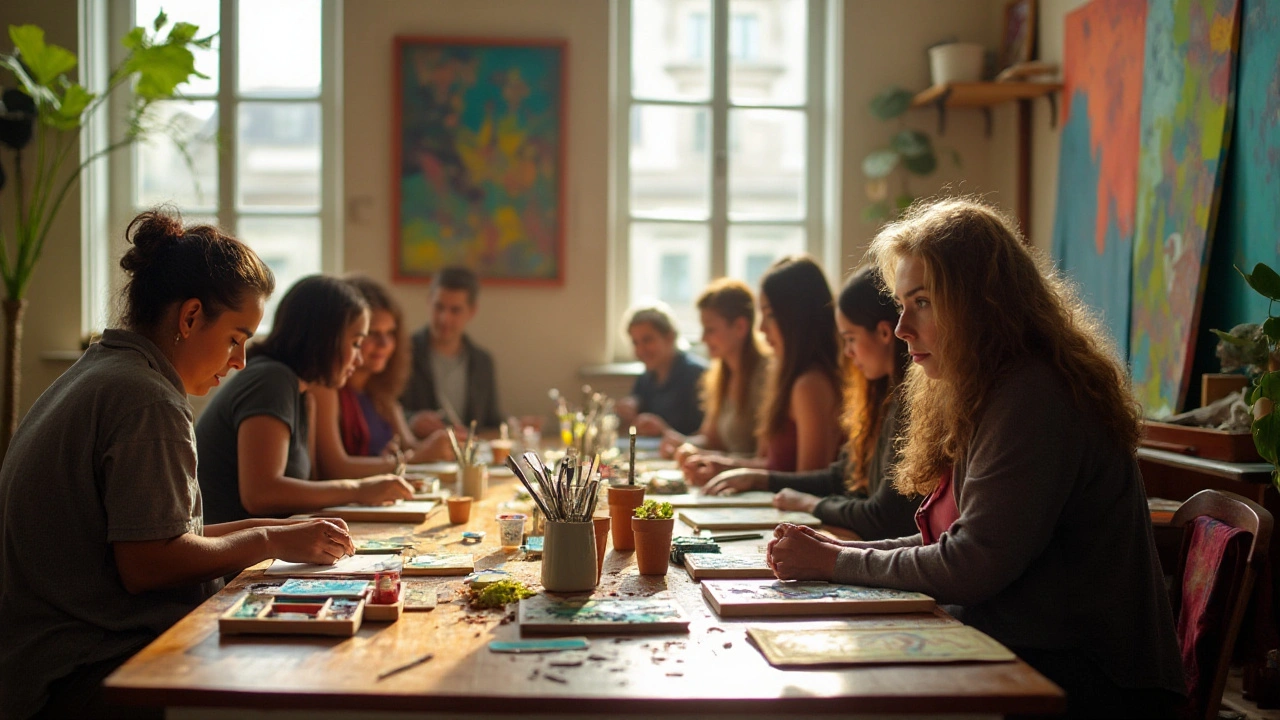In recent years, there's been a noticeable shift towards using creativity as a tool for healing and self-expression. The world of creative arts therapies is booming, responding to an increase in awareness around mental health and the need for diverse therapeutic options.
These therapies aren't just about making pretty pictures or playing music; they reach far deeper, engaging people in a process that allows them to explore their feelings in a non-verbal way. This can be profoundly liberating for those who find words insufficient or overwhelming.
As society continues to evolve, so too does the understanding of what it means to be healthy and whole. Creative arts therapies provide a unique, rich tapestry of methods to support the mind and spirit in ways that traditional approaches might not. This article aims to shed light on how these techniques work and why they're more crucial now than ever.
- The Rise of Creative Arts Therapies
- Understanding Different Modalities
- Benefits of Creative Arts in Healing
- How They Integrate with Traditional Therapies
- Practical Tips for Incorporating Arts into Daily Life
The Rise of Creative Arts Therapies
Creative arts therapies have been steadily making their way into the mainstream, driven by a growing recognition of their unique benefits in promoting mental health and wellbeing. This approach combines various forms of artistic expression—such as art, music, dance, and drama—into therapeutic practice, offering individuals a powerful, non-verbal means to explore and convey complex emotions. These therapies provide a canvas for people to express feelings that they might find difficult to articulate in conventional talk therapy.
The origins of these therapies can be traced back to the early 20th century, when pioneers like Margaret Naumburg and Adrian Hill began exploring how art could aid psychological healing. Naumburg, often referred to as the "mother of art therapy," believed in the potential of spontaneous art as a way to access and understand the unconscious mind. Over time, this belief has been substantiated by research, showing how engaging in creative processes can reduce stress, manage mental health symptoms, and improve cognitive function.
Today, creative arts therapies play a prominent role in a variety of settings, from schools and hospitals to rehabilitation centers and private practices. They cater to a diverse range of populations, including those undergoing mental health treatment, individuals recovering from trauma, and people seeking to enhance personal growth. One study from the American Art Therapy Association highlights that 75% of individuals who participated in art therapy sessions reported a significant decrease in symptoms of anxiety and depression.
The beauty of creative arts therapy lies in its versatility and adaptability. It can be individual or group-oriented, structured or spontaneous, depending on the needs of the participant. As mental health concerns become more prevalent, particularly in the aftermath of global challenges like the COVID-19 pandemic, the demand for therapeutic approaches that offer alternative pathways to healing has surged. People are looking for ways to cope with stress, loneliness, and uncertainty, and creative arts therapy offers a beacon of hope through its inclusive and transformative practice.
"Art can permeate the very deepest part of us, where no words exist." – Eileen Miller
By fostering creative expression, these therapies empower individuals to reconnect with themselves and others in meaningful ways. They create an opportunity to engage the mind, body, and spirit, tapping into innate creativity that lies within all of us. This approach not only emphasizes healing but also encourages ongoing personal development, making it a valuable resource for anyone seeking a deeper understanding of themselves and their emotions. As more research and testimonies highlight its effectiveness, creative arts therapy is sure to continue its rise as a vital component of holistic health and mental wellness strategies.
Understanding Different Modalities
When we talk about creative arts therapy, it’s essential to appreciate the breadth of modalities that exist within this domain. Each modality harnesses the power of creativity differently, providing unique avenues for communication and healing. Art therapy, for instance, uses visual arts to help individuals express themselves. While someone might not be able to talk about their feelings, they might be able to show them through a drawing or painting. The act of putting brush to canvas can often unlock emotions and thoughts that have been hard to articulate. The use of colors, shapes, and textures tends to reveal deeper insights into a person's psyche.
On the other hand, there's music therapy which taps into the universal appeal of music. Whether through listening to melodies or creating new ones, music has a way of touching the soul that very few things can. It helps in reducing stress and has been shown to improve cognitive functioning and emotional well-being. Music therapy can be powerful for those dealing with trauma, as rhythms and beats provide a non-verbal escape and a form of expression. This isn't just anecdotal; studies consistently show that music can positively impact neural responses, leading to physical and emotional healing.
Then we have dance/movement therapy, an approach that incorporates physical expression as a mode of therapy. This modality emphasizes the connection between movement and emotion. Movement becomes a language of its own, highlighting how integrated our body and mind truly are. For individuals who find verbal expression daunting, dance can be an outlet for energy and emotions that need to be released but cannot be spoken.
Drama Therapy
Drama therapy often incorporates role-play, improvisation, and story-telling to help individuals gain insight into their lives and foster change. By stepping into different characters or scenarios, people can experiment with different perspectives and outcomes. This creative exploration is particularly helpful for individuals who might feel trapped in their own stories. It allows them to view problems from a new angle and find solutions they hadn’t previously considered. "The beauty of drama therapy lies in its capacity to promote healing from the inside out," says Peter Langley, a renowned drama therapist.
The diversity of these therapies highlights how important it is to find the modality that resonates with each individual. Not every method will work for everyone, and that's perfectly okay. What's crucial is the willingness to explore and embrace these creative avenues, knowing that they hold the potential to unlock doors to healing that might otherwise remain closed. With growing acceptance and integration into traditional therapeutic practices, creative arts therapies continue to forge and fortify paths to holistic well-being.

Benefits of Creative Arts in Healing
Creative arts therapies have carved a niche as a powerful modality for mental health treatment, exploring the intimate connection between creativity and emotional well-being. One significant benefit of engaging in these therapies lies in their ability to foster non-verbal expression, providing an alternative form of communication for those who might find traditional talk therapy intimidating or ineffective. When words fall short, a paintbrush, a piece of music, or a dance movement can speak volumes. Clients often find that engaging in creative processes helps them unlock hidden emotions, offering insights into experiences that they may not have been able to articulate otherwise.
Another compelling advantage of art therapy and its creative cousins is the enhancement of self-esteem and confidence. Completing an artistic endeavor or expressing oneself through creative arts can instill a sense of accomplishment and boost one's self-image. This is particularly crucial for individuals struggling with depression or anxiety, where creative engagement can serve as a functional and productive outlet for feelings that are often internalized. The act of creating itself becomes a form of empowerment, encouraging individuals to take charge of their healing journey.
"Engagement in artistic activities, either as an observer of the creative efforts of others or as an initiator of one's own creative works, can enhance one’s moods, emotions, and other psychological states." – The National Institutes of Health
Moreover, creative arts therapies are known to improve cognitive abilities. Drawing a connection between physical movement, such as in dance therapy, and mental acuity might seem unusual, but studies have shown that these activities can enhance brain function. This improved cognitive flexibility aids in problem-solving and can even benefit people suffering from neurodegenerative diseases by slowing their progression. Creativity can act as a workout for the brain, nurturing neuroplasticity, which is the brain's ability to reorganize itself by forming new neural connections throughout life, thus fostering better mental health overall.
Reducing Stress and Anxiety
Stress reduction is yet another vital benefit of integrating creative arts into healing practices. The meditative yet expressive nature of activities like painting or playing an instrument helps individuals enter a 'flow state,' where they become fully immersed in their activity. This immersion can break the cycle of rumination — a hallmark of both stress and anxiety disorders. Crafting art doesn't just distract from stressors; it transforms them, channeling negative energies into something tangible and often, something beautiful. These creative acts help in the release of 'feel-good' hormones such as dopamine, enhancing mood and offering a meaningful respite from life’s pressures.
Additionally, the social aspect of creative arts therapy cannot be overlooked. Participating in group art classes or group therapy sessions centered around the arts encourages social interaction and connection, combating feelings of isolation that often accompany mental health struggles. These settings provide a safe space for individuals to share their work, receive feedback, and draw inspiration from others, nurturing a sense of community. In a world where loneliness and social disconnection are increasingly recognized as prevalent mental health issues, the communal aspects of creative arts therapies serve a vital role in psychological and emotional recovery.
How They Integrate with Traditional Therapies
Creative arts therapies, such as art therapy, music therapy, and dance therapy, are increasingly becoming a vital component in the spectrum of therapeutic practices. One of the most fascinating aspects of these therapies is their ability to seamlessly integrate with traditional therapeutic modalities like cognitive-behavioral therapy (CBT) or talk therapy. Imagine the scene where a therapist encourages a patient to draw or paint a representation of their feelings before delving into a dialogue about those emotions. This not only adds depth to the therapeutic process but also facilitates a more comprehensive understanding of the patient's internal world.
A significant advantage of combining creative arts therapies with traditional approaches lies in the flexibility and versatility it offers. It provides therapists with a broader toolkit to tailor sessions according to individual needs. For instance, someone who struggles with verbally articulating trauma might find solace and expression through drama therapy, thus unlocking emotions that were previously repressed.
Research has shown that the integration of these therapies can enhance outcomes significantly. A study published in the Journal of the American Art Therapy Association found that incorporating creative arts therapy in the treatment of individuals with PTSD reduced symptoms more effectively than traditional therapy alone. By employing multiple methods, therapists create layers of support that can address complex psychological issues more holistically.
"Art speaks where words are unable to explain," the renowned art therapist Bernie Siegel once said, emphasizing the profound impact that creative expression can achieve when complemented by traditional therapy techniques.
This integrative approach also fosters a sense of collaboration between the therapist and the patient, as patients engage more dynamically with the therapeutic process. Let's say a session involves creating a piece of art or choosing music that resonates with their current mood; these activities can bridge conversations about feelings and thoughts, creating a more supportive environment for healing. The therapist can gain insights into unconscious patterns or hidden traumas, while the patient may uncover new aspects of their personal narrative.
Furthermore, the integration of creative arts and traditional therapies caters to a wide array of learning styles and personal preferences, making mental health care more accessible and less intimidating. In some cases, traditional therapy might feel too clinical or detached, whereas creative arts therapies can offer warmth and a sense of playfulness which can be comforting for many. It helps demystify the therapeutic process, inviting individuals to participate actively in their healing journey and giving them agency in how they choose to process and express their experiences.
For practitioners, this blend of methods encourages ongoing learning and adaptability, as they refine their skills to include creative interventions. This not only contributes to personal development as a therapist but enriches the quality of care provided. Mental health professionals who incorporate creative arts therapies report seeing improvements in patient engagement and satisfaction, highlighting the synergistic benefits of this approach. As our understanding of mental health expands, the integration of creative and traditional therapies signifies a move towards more inclusive, patient-centered care.

Practical Tips for Incorporating Arts into Daily Life
Art isn't something reserved for the galleries or the concert halls—it's a vibrant part of daily life that can bring joy, understanding, and healing. Whether you're seeking ways to relieve stress, boost your mood, or find a new avenue of self-expression, incorporating elements of creative arts therapy into your daily routine is easier than it might seem. Start with small, manageable steps that fit into your life seamlessly. Setting aside just a few minutes a day for an artistic activity can set a positive tone for your day.
One effective way to make room for art is by turning routine tasks into creative opportunities. For instance, consider keeping a sketchpad or coloring book handy, allowing yourself to doodle while on phone calls or during screen breaks. This can help transition your mind from a work-focused mode to a relaxed state, acting as a gentle reset for your brain. There’s something about the repetitive motion of drawing that slows down your racing thoughts, providing unexpected clarity. Even simple tasks like making a cup of tea or arranging flowers on your dining table can be approached with creativity and mindfulness, turning mundane activities into moments of inspiration.
Create a Personal Art Space
Creating a designated space for creativity can significantly impact how often you engage in artistic activities. You don't need a fancy studio or a separate room; a small corner in your home dedicated to art supplies, instruments, or movement can suffice. This space should encourage you to create freely without judgment or the pressure of perfection. It can be as small as a kitchen table or a cozy nook, what’s important is that it signals to your brain that it’s time to explore and create. When you step into this space, let go of expectations and allow joy to guide your creative process.
"Art enables us to find ourselves and lose ourselves at the same time." – Thomas Merton
For some, the arts offer a path to mental stillness and discovery. Engaging with art can be as meditative and restorative as it is expressive. You might find peace in something as simple as listening to music while painting or improvising on a musical instrument. Explore different mediums to see what resonates most with you: painting for some, dance for others, or perhaps writing poetry. The key is consistency; regular engagement can shift your perspective and mental state over time, much like any other healthful practice.
Join or Form Creative Groups
Sharing art with others can also enhance your experience. Joining a community art class or gathering friends for a weekly create-and-connect session can help maintain motivation and introduce new perspectives. These groups can serve as a source of inspiration and accountability, pushing you to explore new techniques and mediums. Consider hosting a monthly art and wine night, where friends bring supplies, and you all try your hand at different art forms, from painting to pottery. This kind of social activity not only supports your personal growth but also strengthens community bonds.
Music and movement are other phenomenal ways to integrate the arts into everyday life. Start each morning with a few stretches to your favorite song or dance around your living room to shake off the stress of the day. Even singing in the shower or exploring rhythm with everyday objects can introduce artful moments into your routine. There's a playful joy in making noise, and it serves as a reminder to not take life too seriously. Allow yourself to be present and express yourself uniquely, letting your body guide you in ways that words sometimes cannot. The possibilities are endless; the key is to find what suits you and embrace it regularily.
